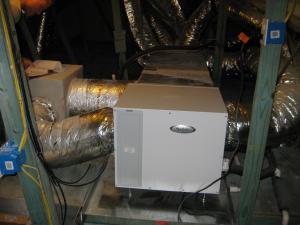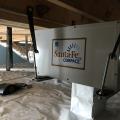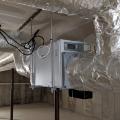Scope
In warm-humid climates, install equipment as needed to maintain indoor relative humidity (RH) at or below 60%.
- Install an HVAC system that includes cooling equipment with controls to operate in dehumidification mode.
- or, Install additional dehumidification equipment that is either stand-alone or integrated into the supply or return of a central forced air system.
- Properly size all heating and cooling equipment to accommodate the design loads for each room as determined using ACCA Manual J, ASHRAE Handbooks, or equivalent software, as well as the pressure drop from all specified filters.
See the Compliance Tab for links to related codes and standards and voluntary federal energy-efficiency program requirements.
Description
High humidity levels inside the home are uncomfortable for occupants and can lead to mold, mildew, and rotting of building materials. Humidity in the homes is measured in terms of relative humidity (RH), which is the ratio between the actual amount of water vapor in the air and the maximum amount of water vapor the air can hold at a given temperature. Excessive humidity will condense on cold surfaces, encouraging the growth of mold and mildew and creating an environment conducive to dust mites and other pests.
Refrigerant-based air conditioning will dehumidify as well as cool the air. It cools by reducing sensible heat (lowering the temperature) and dehumidifies by reducing s latent heat (removing humidity) from the air. If the HVAC system’s coil temperature is below the dew point of the air (the temperature at which water vapor will condense into liquid water), the air conditioning system will remove moisture while also lowering the air temperature. Together, sensible heat and latent heat constitute the cooling load on an HVAC system.
Air conditioning equipment is sized based on peak-load outdoor design temperature, determined by the home’s location. A home’s total cooling load consists of a sensible load (temperature component) and a latent load (humidity component). Conventional systems generally dehumidify well during peak-load temperatures when the system operates for extended periods. At lower temperatures, the system cools the house relatively quickly and cycles off, but provides proportionally less dehumidification. As a result, indoor humidity levels tend to rise. This effect is exacerbated during cloudy or more humid days and also for newer, energy-efficient homes, which tend to have lower sensible loads but latent loads that can be the same or higher due to ventilation requirements (Home Innovation Research Labs 2017).
For maximum effectiveness, a well-designed HVAC system depends on an accurate room-by-room calculation of the heating and cooling loads. The system cooling load is calculated by summing the amount of sensible heat and latent heat that needs to be removed from the air. Important factors that contribute to sensible and latent heat calculations include outdoor climate, building orientation, building design, and other factors.
The optimal cooling system will be sized to meet its projected loads, resulting in better temperature and humidity control. Oversizing the cooling system can cause short-cycling of the equipment (i.e., short periods of “on” time when cooling is provided followed by long periods of “off” time when no cooling is provided). In homes with over-sized air conditioners, the thermostat quickly reaches the desired set point before moisture can condense on the coil and be removed from the home. In this situation, the temperature in the home drops but the relative humidity climbs.
In order to ensure proper sizing of heating and cooling systems, the HVAC industry uses the “Manual J” calculation worksheet developed by the Air Conditioning Contractors of America (ACCA). (See description below.) The Manual J worksheet accounts for factors such as the local climate, the orientation of the home, and the thermal performance of the building enclosure including windows, roofs, walls, and floors. After completing a Manual J load calculation, the HVAC designer then uses a procedure described in ACCA Manual S to properly select equipment capable of meeting both the sensible and latent heat loads in the home.
In hot-humid climates, the air conditioner alone may not be able to remove enough latent heat to keep relative humidity below 60%. In such cases, the HVAC designer should consider adding dehumidification by adding dehumidification controls or a separate dehumidifier. For more on solutions specific to Hot-Humid Climates, see the Home Innovation Research Labs TechNotes, Humidity Control: Supplemental Dehumidification in Hot-Humid Climates.
How to Improve Dehumidification in Warm-Humid Climates
Types of equipment for providing dehumidification to homes include stand-alone dehumidifiers, central fan-integrated dehumidifiers, and additional dehumidification controls for existing HVAC systems.
Stand-Alone Dehumidifiers
Stand-alone dehumidifiers separate portable appliances (Figure 1). These self-contained portable units include all necessary components: the fan, controls, and coils. They generally run from an outlet plug and can be stored away during non-humid seasons. Some units have condensation reservoirs that must be emptied on a regular basis – controls will sound an alarm bell or trigger a light when the unit is full and will shut down operation to avoid spillage. Many units have both a reservoir bucket and a drain line, giving the homeowner the option to use either. If a drain line, it must be routed to the outdoors or to a drain inside the home. Portable dehumidifiers use a fan to pass room air over the condenser coils to cool the refrigerant for cycling. The exhaust air will be slightly warmer than the room air.
The major benefit of the stand-alone dehumidifier is the ability to control the indoor relative humidity in the home without having a major effect on temperature; i.e., they do not reduce indoor temperature like an air conditioner would while dehumidifying. This is valuable for climates that have a low sensible load but higher humidity (latent load), such as coastal climates.
Portable dehumidifiers have no installation costs so they are lower in cost than stand-alone ducted systems and systems integrated into a central air handler and they have about the same life expectancy as ducted and integrated systems. They may have less capacity depending on the size purchased and they may not dehumidify large, multilevel homes as consistently as centrally integrated systems; however, they can provide zoned dehumidification and provide good humidity control for problem areas like basements, kitchens, laundry rooms, or bathrooms.
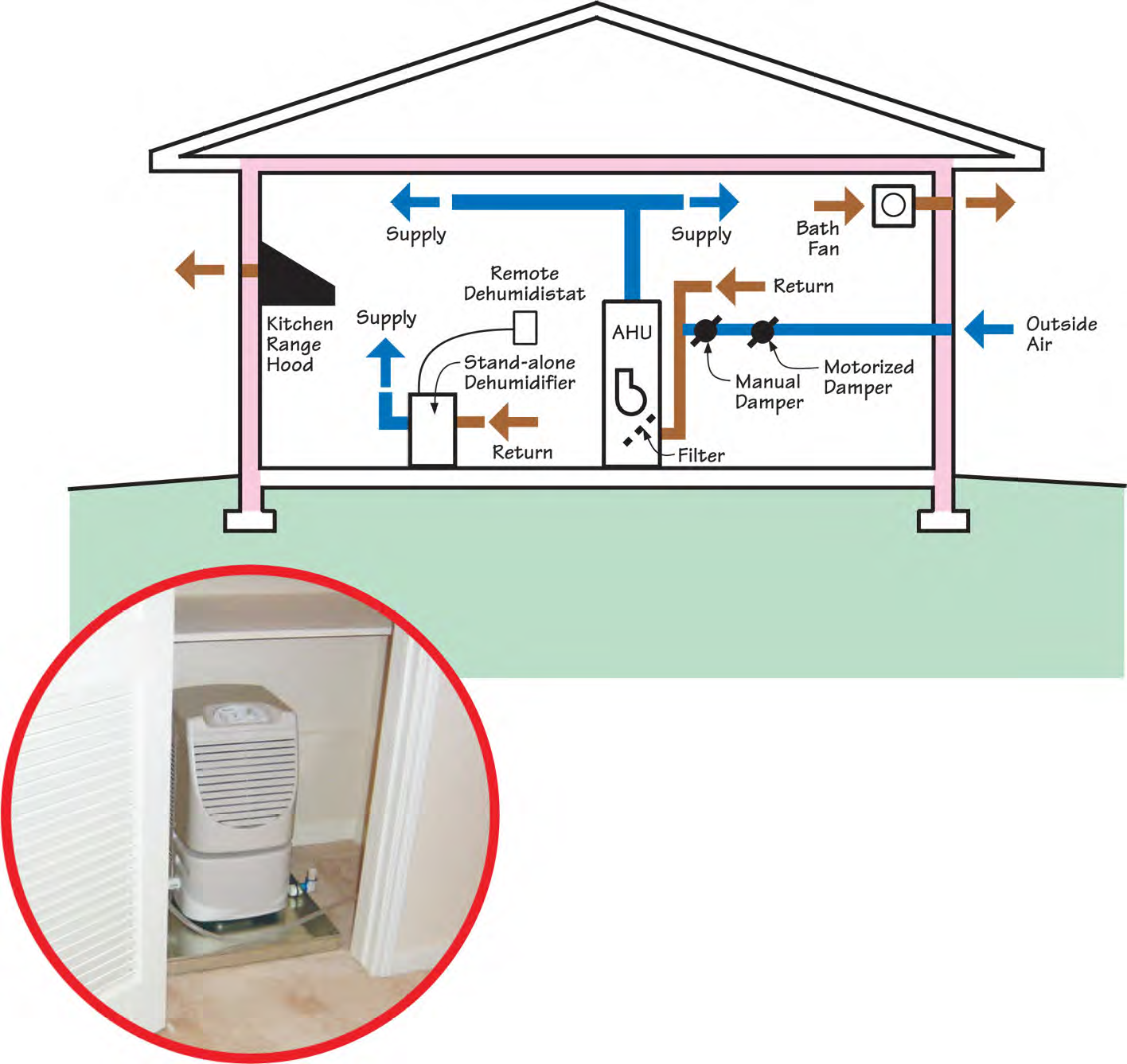
Independent Ducted Dehumidifiers
An independent ducted dehumidifier is ducted separately from the home’s heating and cooling equipment (Figure 2). The dehumidifier can be installed in an attic, basement, crawl space, mechanical room, or closet and ducted to draw air from and supply air to the conditioned space. It could have one or more supply and return registers. Because it does not rely on the central HVAC system for distribution, it is ideal for homes with ductless HVAC systems. The inlet and outlet grilles should be separated as far as is practical within the home to improve air distribution. Locate the outlet grille so warm outlet air does not affect occupant comfort or a thermostat control. A wall-mounted humidistat control is recommended to measure room RH and reduce dehumidifier short-cycling.

Integrated Ducted Dehumidifiers
A ducted dehumidifier can be integrated with the central air conditioning distribution system as shown in Figure 3. The fan inside the dehumidifier unit draws air from the living space and provides the dehumidified air to either the supply side or return side of the central air handler (as shown in Figures 4, 5, and 6). Figure 7 shows a dehumidifier that draws in air from both a return air grille located inside the home and an outdoor air intake so the system provides fresh air ventilation as well as dehumidification. The air is pulled through the dehumidifier and pushed into the supply air stream with the aid of the blower fan in the dehumidifier. Because this system warms the supply air slightly, during cooling periods this will force the air conditioner to run a little bit longer, which will dehumidify the air even more. Most dehumidifier include a high-efficiency filter.
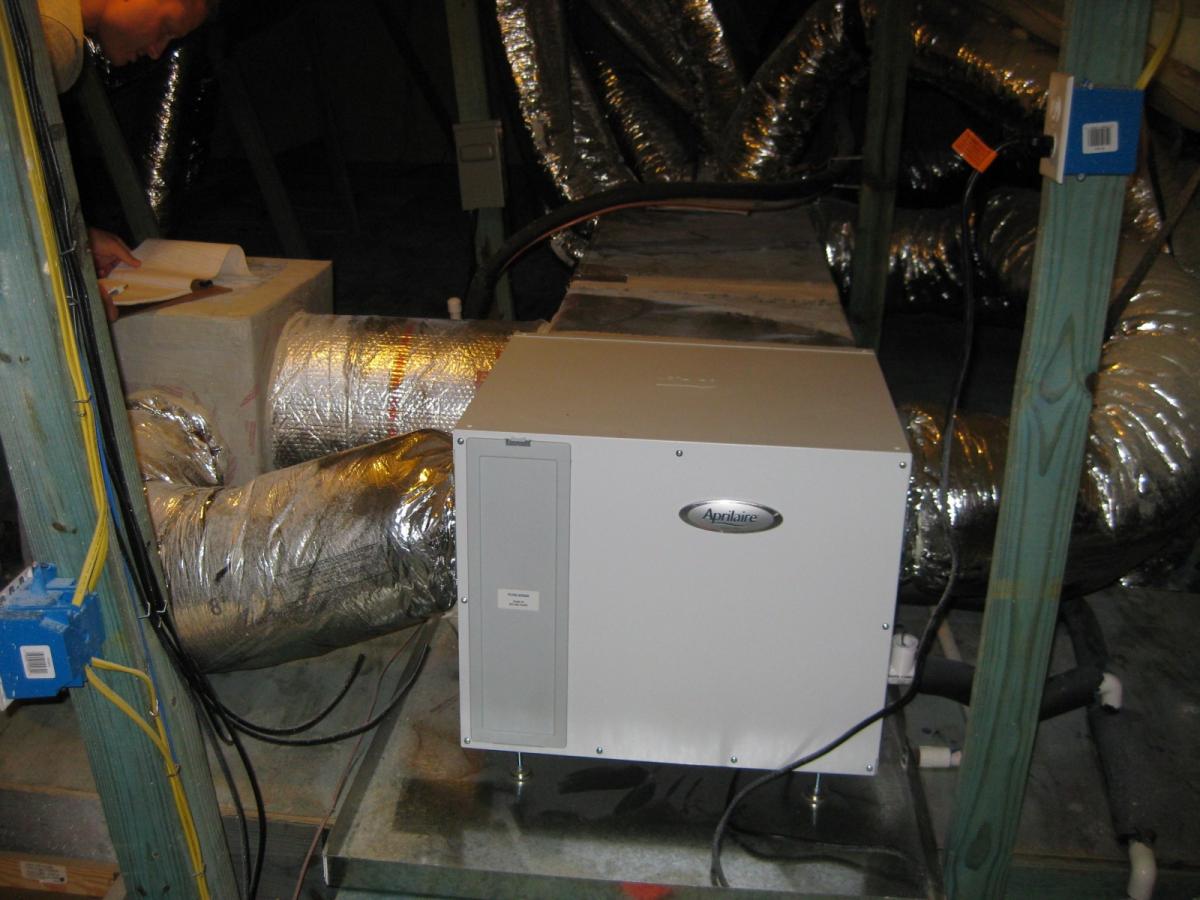


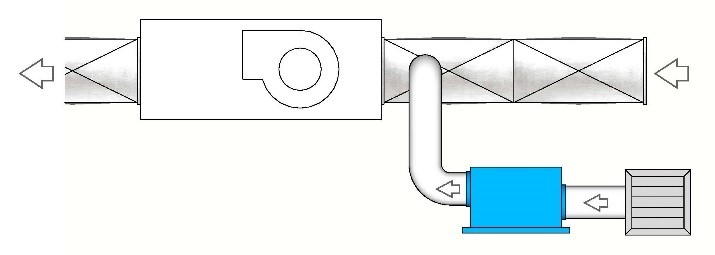

Additional Dehumidification Controls
Another option for reducing humidity in the home is to add additional dehumidification controls to the HVAC system that will operate the cooling system at a slower fan speed when in dehumidification mode. This allows the air to spend more time on the cold coil surface, which results in additional dehumidification. Because the system is still operating as an air conditioner, it is also decreasing the temperature in the home, which may result in potential comfort issues.
Adding controls to the HVAC system is generally less expensive than installing a central or stand-alone dehumidifier. However, this option is best suited to climates with shorter shoulder seasons because of the potential for comfort issues while running the air conditioner in cooler weather. The stand-alone dehumidifier may be a more costly upfront investment, but stand-alone dehumidifiers generally use less energy and thus cost less to operate then central air handlers and also operate with less risk of comfort issues in the home.
How to Select Dehumidification Equipment
- The HVAC contractor is required to conduct a Manual J calculation of HVAC system design loads. See description below.
- Use ACCA Manual S to right-size the HVAC. Supplemental dehumidification is not intended to be used as a means for compensating for over-sized HVAC equipment or excessive building leakage rates.
- Calculate the dehumidifier capacity needed, as described below.
- Select the dehumidifier option desired (stand-alone, independent ducted, integrated ducted) and install per manufacturer’s instructions.
- Show equipment and installation details on plans, specifications, and scopes of work for subcontractors.
- Specify recommended control set points, as required, for enhanced dehumidification (e.g., initiates at 55% RH) and supplemental dehumidification (e.g., dehumidifier initiates at 60% RH).
- Avoid exhaust-only ventilation as it tends to depressurize a house, which, in turn, may increase infiltration of outdoor air and indoor humidity.
- Provide cautions for homeowners:
- Aquariums, large numbers of house plants, and hanging clothes to dry indoors all add significant amounts of moisture into the home.
- urning off the HVAC system or using a high set point (e.g., 80°F) could allow the relative humidity to rise (if installed supplemental dehumidification is integrated into the HVAC).
- Don’t over ventilate during periods of extreme outdoor heat and humidity. High ventilation rates during these conditions could overcome the dehumidifier’s ability to maintain relative humidity at below 60% indoors.
How to Conduct a Manual J Calculation
A contractor can utilize one of the HVAC-industry adopted software programs based upon Manual J to assist with calculating HVAC system design loads. Consult the ACCA website for a list of software programs to perform Manual J calculations.
A Manual J report includes climatic data, such as the “Outdoor Design Conditions” (found in Table 1 of Manual J 8). This information includes the local elevation, dry-bulb and wet bulb temperatures, and daily temperature range.
- Indoor design temperature and relative humidity for heating and cooling.
- Heat loss and gain for heating and cooling for each of the following elements of building loads:
- windows and glass doors
- skylights
- wood and metal doors
- above and below grade walls ceilings/roofs floors/foundations
- air infiltration
- internal gains – appliances and occupants duct location and tightness
- ventilation loads.
Note: Indoor airPLUS Specification 7.3 requires the builder to provide the homeowner with a signed copy of the HVAC duct and ventilation system design documentation, including Manual J and Manual D analysis reports. (Manual D requirements are discussed in Indoor airPLUS Specification 4.2.) These reports should include room loads, duct system criteria by room, and duct layouts (e.g., drawings illustrating return sizes, supply trunks, run-out duct sizes, and the cubic feet per minute (cfm) of conditioned air delivered to each room).
How to Size the Dehumidifier
The Association of Home Appliance Manufacturers (AHAM) provides guidance on selecting dehumidifier capacity based on house square footage and indoor dampness conditions. Manufacturers provide recommendations based on house square footage, but recommendations vary by manufacturer. ACCA Manual S provides a method that uses the already required Manual J load calculation (Home Innovation 2017). Here is a more detailed methodology based on the Manual J calculation that takes into account performance at design conditions (from Calcs Plus).
- After doing the Manual J, take latent load from the Manual J calculation (for example 3,868 Btu) and divide it by 1,054 Btu (which equals about 1 pint of water). This will give you pints per hour.
3,868/1,054 = 3.7 pints per hour - Multiply this by 24 to get pints per day.
24 Hours x 3.67 Pints per Hour = 88.08 Pints per Day - Then assume your air conditioner will cover about 15% of the humidity load if properly sized.
Multiply pints per day by .85 = capacity of dehumidifier.
88.08 pints x 0.85 = 74.8 pints capacity You will want to size your dehumidifier for design conditions. Manual J design conditions are 75°F, 50% relative humidity (see Figure 8).

Figure 8. ACCA Manual S uses interior design conditions of 75°F and 50% relative humidity for specifying HVAC equipment. (Source: Calcs Plus.) - At these design conditions, the dehumidifier is operating at about 66% capacity. If the dehumidifier is only operating at 66% capacity, at design conditions, it is only removing 49.5 pints of water.
75 pints cap x .66 = only 49.5 pints in a day. - You want to size the dehumidifier so that when it reaches design conditions it will turn off rather than running constantly, so it must be sized for larger than 75-pint capacity.
75 pints / 0.66 = 113 pints capacity - Therefore, based on this example, you would install a dehumidifier that has a water removal capacity of at least 113 pints per day.
Success
- The HVAC contractor is required to conduct a Manual J calculation of HVAC system design loads.
- Use ACCA Manual S to right-size the HVAC. Supplemental dehumidification is not intended to be used as a means for compensating for over-sized HVAC equipment or excessive building leakage rates.
- Show equipment and installation details on plans, specifications, and scopes of work for subcontractors.
- Specify recommended control set points, as required, for enhanced dehumidification (e.g., initiates at 55% RH) and supplemental dehumidification (e.g., dehumidifier initiates at 60% RH).
- Avoid exhaust-only ventilation as it tends to depressurize a house, which in turn may increase infiltration of outdoor air and indoor humidity.
Climate
The Warm-Humid region is the area below the white line, which includes all of climate zone 1, all of climate zone 2A, and portions of climate zone 3A, as shown in the IECC climate zone map below.
The map in Figure 1 shows the climate zones for states that have adopted energy codes equivalent to the International Energy Conservation Code (IECC) 2009, 12, 15, and 18. The map in Figure 2 shows the climate zones for states that have adopted energy codes equivalent to the IECC 2021. Climate zone-specific requirements specified in the IECC are shown in the Compliance Tab of this guide.


Training
Compliance
Compliance
Retrofit
Add dehumidification to an existing home if indoor relative humidity levels exceed 60% and if moisture issues are apparent, such as mold, mildew, or occupant complaints of humidity, and no water leakage or water intrusion sources are found.
See the Description tab for dehumidification equipment options and installation guidance.
The U.S. Department of Energy’s Standard Work Specifications offer additional guidance on dehumidification equipment.
More
More Info.
Access to some references may require purchase from the publisher. While we continually update our database, links may have changed since posting. Please contact our webmaster if you find broken links.
The following authors and organizations contributed to the content in this Guide.
Sales
Whole-House Dehumidification = Whole-House Humidity Control
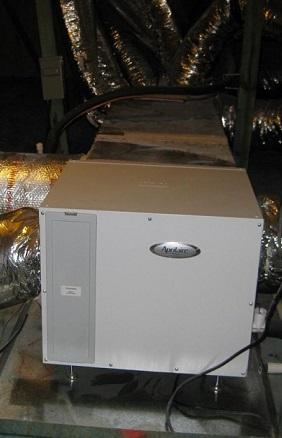
In hot, humid climates, reducing indoor humidity is an important part of making the homes’ indoor environment more comfortable, more durable, and healthier. In very humid climates, the air conditioner alone may not be able to remove enough latent heat to keep relative humidity below 60%. In such cases, supplemental dehumidification and humidity controls can be added to the HVAC system. This can include stand-alone dehumidifiers, a dehumidifier that is integrated into the central air conditioning system, or dehumidification controls that are added to the HVAC system to operate the cooling system for longer periods at a slower fan speed to allow more time for the coil to remove humidity from the air.
